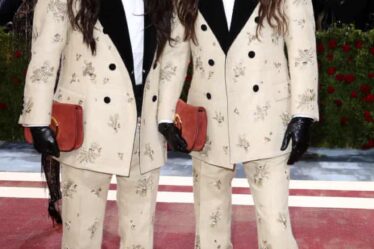When it comes to artificial intelligence, Condé Nast seems to be taking an “if you can’t beat ‘em, join ‘em” approach.
This week, the publisher announced it had inked a partnership with OpenAI, the Microsoft-backed company behind ChatGPT. Going forward, content from Condé Nast publications — including Vogue, Vanity Fair and GQ — will appear on OpenAI’s platforms, including ChatGPT and a prototype version of the forthcoming SearchGPT.
In a memo announcing the partnership to Condé Nast staff, chief executive Roger Lynch wrote that it is a way “make up for some of that revenue” that had been lost as tech companies “eroded publishers’ ability to monetise content.” He argued that in partnering with OpenAI, Condé Nast would be able to protect and invest in its journalism.
In some ways, Condé Nast is learning from past mistakes. Legacy media was slow to adapt to the internet, going back to the rise of Craiglist classified ads three decades ago. It’s only within the past decade that Condé Nast and its primary rival, Hearst, began meaningfully investing in their titles’ websites. That delay cost publishers dearly. Tech giants like Meta and Google began syphoning away their ad dollars. Even as media properties tried to use social media and search to their advantage, tech companies have implemented rapidly-changing strategies (remember the “pivot to video”?) that further impacted their bottom line.
From the moment ChatGPT was released nearly two years ago, media watchers conjured up similar visions of AI-generated content replacing traditional journalism (not to mention traditional marketing, traditional social media and countless other fields). While the internet is now awash in robot-written articles, Instagram ads and tweets, much of that content is error-ridden clutter.
That is changing fast. Google’s AI overview scrapes text from a publication’s website and condenses it into a bite-sized summary that displays on their results page. Start-ups like Perplexity offer AI-generated search results that negate the need to ever click a link; they’ll soon to be joined by OpenAI’s SearchGPT. Publishers have already found it’s had a negative impact on their traffic.
Teaming up with OpenAI could help Condé Nast get ahead of the curve. Supporters would argue that AI isn’t going anywhere, it’s better to figure out how to use it for your advantage — and nab a share of the revenue pie — early on.
Critics, however, might argue, Condé Nast’s new partnership is akin to getting into bed with the devil; they see deals with AI search engines as the pivot to video of the 2020s. Notably, The New York Times sued OpenAI for copyright infringement in December, arguing that the company used Times articles to train its large language models without the paper’s consent. This spring, a group of eight daily newspapers owned by Alden Global Capital, which includes the Chicago Tribune and the New York Daily News, sued OpenAI and Microsoft for the same reason. The Times case in particular promises to be a watershed moment for the future relationship between AI providers and media companies.
However, there is a middle ground between the routes taken by Condé Nast and The New York Times. Also this week, Axios reported that The Washington Post was investing in developing AI tools for its journalists. Vineet Khosla, the Post’s chief technology officer, said that the paper wanted to build these tools in-house because then they could create “a far superior product than just the general purpose stuff you get from Big Tech.” The idea being that the best way to outcompete AI is to offer quality journalism that can’t be found in an auto-summarised result spit out by SearchGPT or Perplexity. It’s safe to assume Condé Nast and the Times are exploring ways to use AI as well, even as they embrace or pick public fights with the technology’s leading names, respectively.
Over the next few years, the question of what to do about AI will demand answers. The best ones will be able to figure out how to use it to their advantage — but the jury’s still out on what that looks like.
THE NEWS IN BRIEF
FASHION, BUSINESS AND THE ECONOMY

Chanel buys a stake in independent Swiss watchmaker MB&F. The Max Büsser & Friends brand, known for unusual designs and innovative movements, will sell a 25 percent stake to Chanel. The agreement promises to bring stability to the 19-year-old watchmaker amid an industry-wide downturn in demand after a pandemic-era boom.
Macy’s tempers annual revenue view on weak demand for pricier goods. The company now expects annual net sales of $22.1 billion to $22.4 billion, compared with its prior forecast of $22.3 billion to $22.9 billion. The forecast cut was a result of “a more discriminating consumer and heightened promotional environment,” Macy’s said.
Amer Sports raises guidance after strong second-quarter earnings. Amer reported revenue of $994 million for the quarter ended July, up 16 percent from the same period last year. The company also credited heightened demand in China for driving “exceptional growth and profitability” for Arc’teryx.
Sarah Jessica Parker Shutters shoe line. The actress launched the brand in 2013 alongside George Malkemus III, the fashion executive responsible for turning Manolo Blahnik into a household name in the US. Malkemus aspired to do the same with Parker’s collection. The company’s flagship store will remain open until Aug. 25.
Walmart sells $3.74 billion JD.com stake to focus on its own China operations. The US retail giant plans to double down on its warehouse business Sam’s Club in China after the stake sale that underscores the country’s e-commerce sector is losing its appeal. Shares of JD.com have fallen around 70 percent from their peak in early 2021.
TJ Maxx parent raises annual profit forecast after strong second quarter. The company reported net sales of $13.47 billion in the quarter ended Aug. 3, compared with analysts’ estimates of $13.31 billion. It also maintained the upper end of its annual comparable sales forecast of a 3 percent rise.
Urban Outfitters shares sink on disappointing sales growth. The company reported Wednesday that comparable sales in its retail segment rose 2 percent, below analysts’ average estimate of 2.94 percent. Comparable sales at its core Urban Outfitters brand also came in below expectations.
Farfetch to shutter its e-commerce software service. The luxury e-tailer is closing Farfetch Platform Solutions, which provides online shopping tools for retailers like Harrods, as operating costs drags down Coupang’s profits. Coupang, which acquired Farfetch last December, reported a net loss of $105 million in the second quarter that ended in June.
Miuccia Prada and John Galliano among nominees for BFC Designer of the Year award. Chemena Kamali, Rick Owens, Pieter Mulier and Jonathan Anderson were also named nominees.
Patagonia gives US workers a day off in late October to vote early. The outdoor retailer has closed its stores, warehouses and offices on Election Day since 2016, but it’s switching to Oct. 29 this year to let its nearly 2,000 US workers vote early or volunteer.
FTC ban on worker non-compete deals is blocked by a federal judge. The ruling represents a significant blow for the FTC and further divides the judiciary over the regulator’s powers. The rule is likely to be headed for appellate review.
THE BUSINESS OF BEAUTY

Estée Lauder sees annual sales below estimates on China weakness. The company said revenue in its current fiscal year will see between a 1 percent decrease and a 2 percent increase. The cosmetics giant cited continued declines in prestige beauty sales in China.
Coty misses revenue estimates on cautious retail orders and Lacoste licence sale. Coty’s fourth-quarter net revenue rose nearly 1 percent to $1.36 billion, missing LSEG estimates of $1.38 billion. Like-for-like sales at its prestige segment, which houses brands such as Burberry and Gucci, were up 6 percent.
LVMH’s Sephora cuts around 10 percent of staff in China as woes deepen. Sephora China has fired both office and store staff while persuading others to resign, with an estimated 10 percent of more than 4,000 employees in the country affected.
Fresha secures $31 million from J.P Morgan to develop salon robots. With its new funding, Fresha is exploring the possibilities of research and development of machine learning as well as AI robots to perform tasks at salons normally done by humans. Not yet profitable, Fresha’s revenue grew by 67 percent in 2023.
PEOPLE

Estée Lauder CEO Fabrizio Freda to retire. No successor has yet been appointed, but the board of directors is “well advanced” in its CEO succession plan, and has considered internal and external candidates. Freda will lead the company until a successor is appointed, and remain on as an advisor throughout 2026.
Longtime FIT president Joyce Brown to step down. Brown, who became the first woman and first Black American president of FIT in 1998, is credited with helping to modernise the college by improving student diversity and expanding its degree programmes. FIT will use the academic year to search for Brown’s replacement.
MEDIA AND TECHNOLOGY

Condé Nast inks partnership with OpenAI. The deal will allow content from Condé Nast publications to be displayed on OpenAI’s platforms, including AI chatbot ChatGPT and a prototype version of SearchGPT. Condé Nast CEO Roger Lynch said the partnership with OpenAI will contribute to revenue.
Compiled by Yola Mzizi.



